The Northern Yellow-Cheeked Crested Gibbon, or Nomascus annamensis, is an exclusive primate species found in Cambodia, Lao PDR, and Vietnam. These gibbons form monogamous family units, primarily maintaining a frugivorous diet with occasional inclusions of leaves, young shoots, flowers, squirrels, and lizards. Their unique ecological role and behavioral patterns make them a compelling subject for research and conservation efforts.
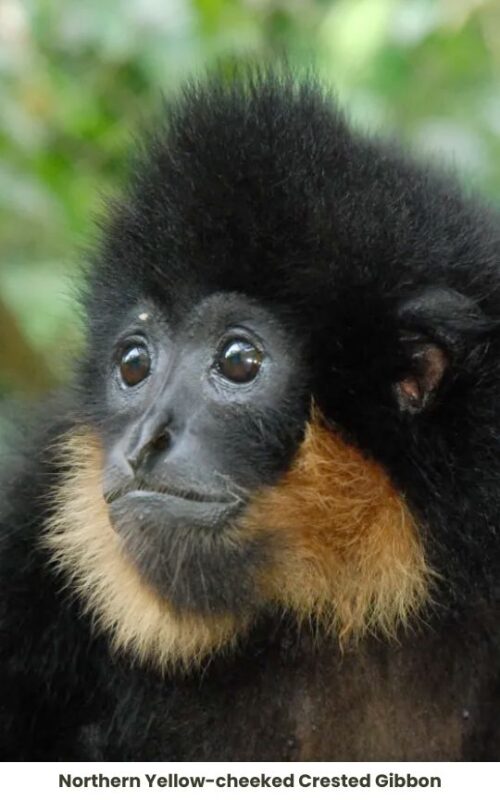
Taxonomy and Classification of Northern Yellow-cheeked Crested Gibbon:
Regnum: Animalia
Phylum: Chordata
Class: Mammalia
Ordo: Primates
Familiar: Hylobatidae
Genus: Nomascus
Species: Nomascus annamensis
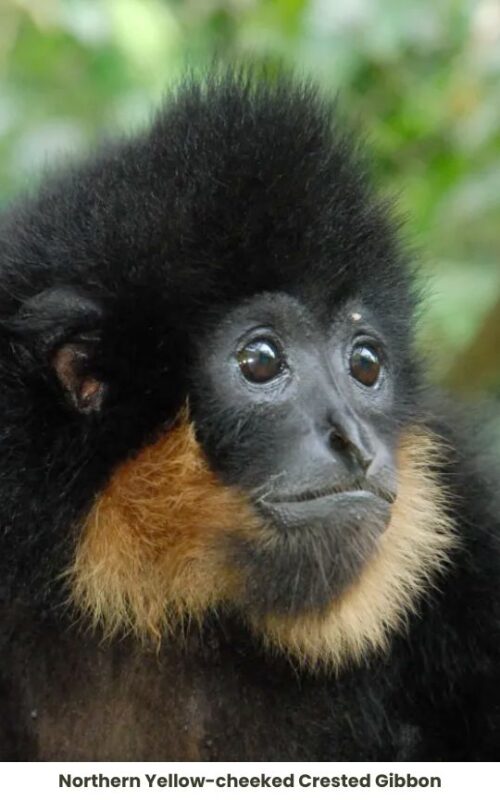
The Northern Yellow-Cheeked Crested Gibbon, scientifically known as Nomascus annamensis or the Northern Buff-Cheeked Gibbon, currently holds an Endangered status. This designation stems from a suspected population decline exceeding 50% over the past 45 years, primarily attributed to the detrimental impacts of logging, agricultural encroachment, and hunting. Ongoing threats, including habitat loss, fragmentation, and the consequences of wildlife trade, compound the challenges faced by this species. The anticipatory trajectory foresees a continued decline over at least 15 years into the future.
Recent advancements in genetic and vocal studies have unequivocally confirmed the specific identity of the Northern Yellow-Cheeked Crested Gibbon. This clarification distinguishes it from its closest relative, Nomascus gabriellae, as documented in studies by Thinh et al. (2010a, 2010b, 2010c), Blair et al. (2011), and Roos et al. (2013).
The discovery of the Northern Yellow-Cheeked Crested Gibbon in 2010 marked a significant addition to the crested gibbon genus, Nomascus. Prior to this revelation, all crested gibbons were erroneously believed to belong to the same species, Nomascus concolor. Subsequent research, utilizing modernized methods for gathering and analyzing genetic, morphological, and auditory data, has debunked this classification. Presently, six distinct crested gibbon species are recognized, including the newly identified Northern Yellow-Cheeked Crested Gibbon. Notably, the term Nomascus concolor now exclusively denotes the black crested gibbon found in northern Vietnam, northwestern Laos, and southwestern China.
Before 2010, there was a misconception that only one species of yellow-cheeked gibbon, Nomascus gabriellae, existed. However, the discovery of Nomascus annamensis in 2010 led to a geographical reclassification of the species. The southern population retained the original scientific name, while the novel species in the northern region was christened as Nomascus annamensis. Common names were also adjusted to reflect their respective locations, with one being designated for the southern population and the other for the northern counterpart.
Appearance
Gibbons, although visually resembling monkeys, belong to the category of apes, characterized by the absence of tails. Differing from larger apes such as bonobos, chimpanzees, gorillas, and orangutans, gibbons are notably smaller in size, a requisite adaptation for their arboreal lifestyle spent predominantly in the canopy. Noteworthy variations in appearance based on sex and age characterize the Northern Yellow-Cheeked Crested Gibbon. Infant gibbons are born with a whitish, buffy color, transitioning to black coats around six months, a trait retained for life by males. In contrast, adult females revert to a lighter pelage in adulthood, featuring an orange hue distinct from their earlier appearance.
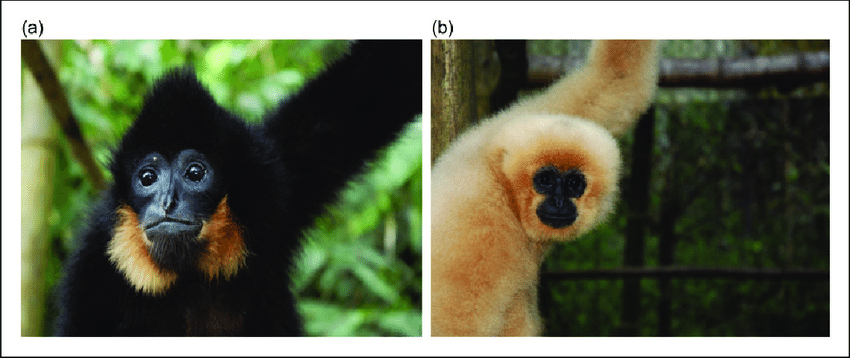
In terms of size, minimal sexual dimorphism is observed in Northern Yellow-Cheeked Crested Gibbons. On average, males weigh around 15 pounds (7 kg) and measure approximately 18 inches (46.2 cm) in head and body length. The precise average weight of female Northern Yellow-Cheeked Gibbons is currently undisclosed, but with an average length of just over 17 inches (43.8 cm), it is reasonable to infer that their weight does not significantly differ from that of the average male.
Although the lifespan of Northern Yellow-Cheeked Gibbons has not been extensively studied, some gibbon species are recognized to live beyond 30 years in their natural habitat.
Adult male Northern Yellow-Cheeked Gibbons present a stark black appearance, occasionally adorned with a brownish tinge on their chest. Illuminated by sunlight, silver strands of hair within their coats become discernible. Unique to males are the species’ signature cheek patches, displaying individual variation in colors such as golden or buffy. Crested gibbons, including the Northern Yellow-Cheeked species, pose challenges for visual identification in the wild. Researchers historically grappled with classification due to this difficulty, emphasizing the crucial role of observing males’ cheek pouches for accurate differentiation.
Conversely, adult female crested gibbons, including the Northern Yellow-Cheeked variety, share indistinguishable features regardless of species. Lighter coats and a black crest atop the head characterize females, with variations in the crest’s shape and position among individuals. Some females also exhibit darker fur on their chests, contributing to the overall intricacies of their visual characteristics.
Are you looking for Wildlife Tours in Vietnam?
WANEE VIETNAM is your go-to destination for "Wildlife Tours in Vietnam", specializing in Birding, Primate Watching, Herping, Photography Tours and Educational Tours led by our expert guides.Habitat and Distribution:
Nomascus annamensis thrives within expansive regions of both broadleaf evergreen and semi-evergreen forests, flourishing at elevations spanning from 100 to 1,200 meters above sea level. While primarily adhering to a frugivorous diet, this species integrates substantial quantities of leaves, young shoots, and flowers into its nutritional repertoire. Remarkably, there are documented instances of individuals feeding on Finlayson’s Squirrel, with a single record involving an adult female, as well as the consumption of lizards. Additionally, communal food-sharing behaviors have been observed, as noted in studies by Geissmann (1995) and Duc et al. (2016).
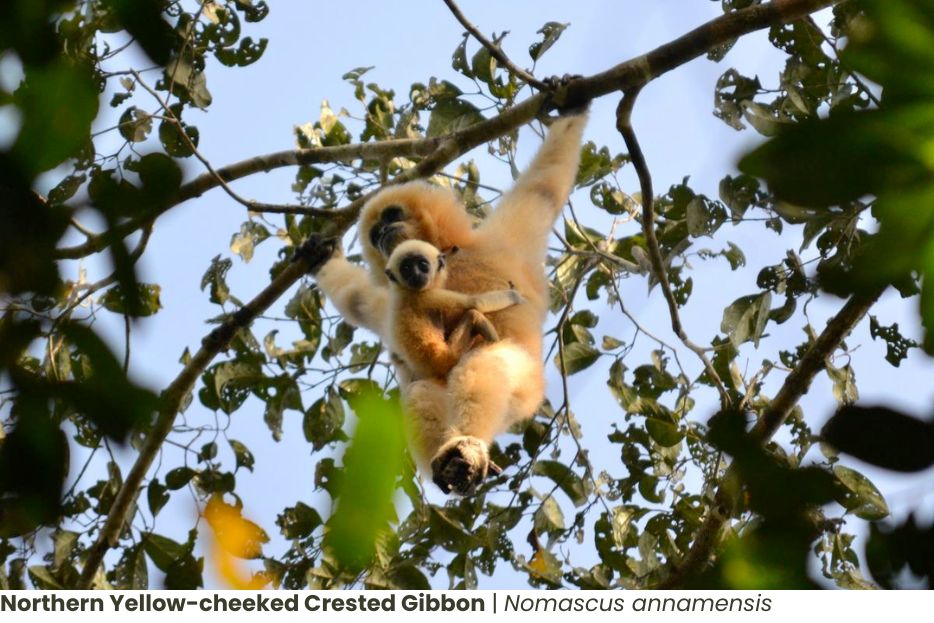
In terms of terrestrial habitat, Nomascus annamensis predominantly resides in forested areas, encompassing both broadleaf evergreen and semi-evergreen forest types. This species is situated along the border regions of Vietnam, Lao PDR, and Cambodia, where the ecological landscape aligns harmoniously with its preferred forested environments.
Behavior and Social Structure:
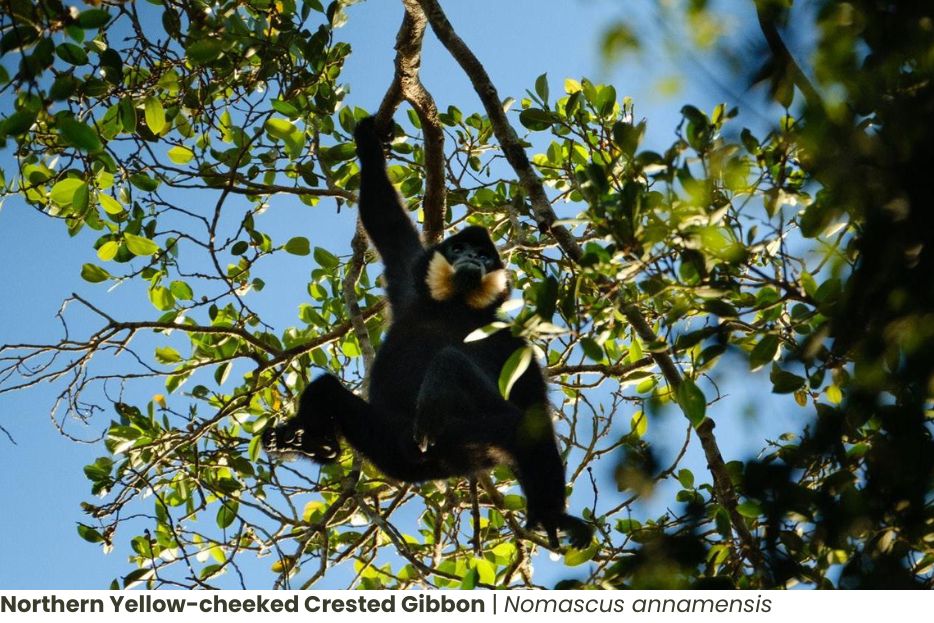
The Northern Yellow-Cheeked Crested Gibbon, or Nomascus annamensis, is characterized by its diurnal and arboreal nature. With an activity budget consisting of 32% inactivity, 30% travel, 26% feeding, 10% social, and 2% other, these gibbons typically form monogamous family groups, exhibiting a home range of approximately 50 hectares (Frechette et al. 2017).
Living predominantly in arboreal environments, these gibbons, known for their early-rising habits, spend their lives high in the canopy. Gibbons are territorial and tend to socialize primarily with immediate family members, employing grooming and singing as mechanisms to reinforce familial bonds. Their primary mode of locomotion, brachiation, allows for graceful navigation through the canopy at speeds of up to 35 mph (56 km/h). Unique physiological adaptations, including ball and socket joints in the wrists, rotating shoulder joints, and a well-developed cerebellum, contribute to their exceptional balance and agility.
Gibbons exhibit regional dialects in their vocalizations, which researchers use for species identification. Northern yellow-cheeked gibbons, situated along the border of Vietnam, Lao PDR, and Cambodia, engage in morning singing rituals to reconnect with family members and establish territory. Their vocal repertoire, distinct by sex, evolves through years of practice, with juveniles initially mimicking their parents.
Facial gestures, body language, and grooming are essential forms of communication among gibbon family members. These social primates play a vital role as seed dispersers, promoting forest regeneration and preserving biodiversity through their fruit-eating habits. Despite their significant ecological contributions, gibbons, including the Northern Yellow-Cheeked variety, are often overlooked, earning them the moniker “the forgotten apes.” Ongoing research aims to unravel the intricacies of gibbon vocalizations and communication, contributing to their conservation efforts and shedding light on the complexity of these fascinating primates.
Reproductive Biology:
Gibbons establish enduring monogamous relationships between males and females, forming the fundamental social unit known as the nuclear family. While these partnerships generally persist throughout their lives, occasional separations may occur. Despite being socially monogamous, evidence suggests that gibbons may not be sexually monogamous. Nevertheless, the family unit remains crucial for the upbringing of young gibbons, with both parents investing time and energy in ensuring their offspring’s survival and success.
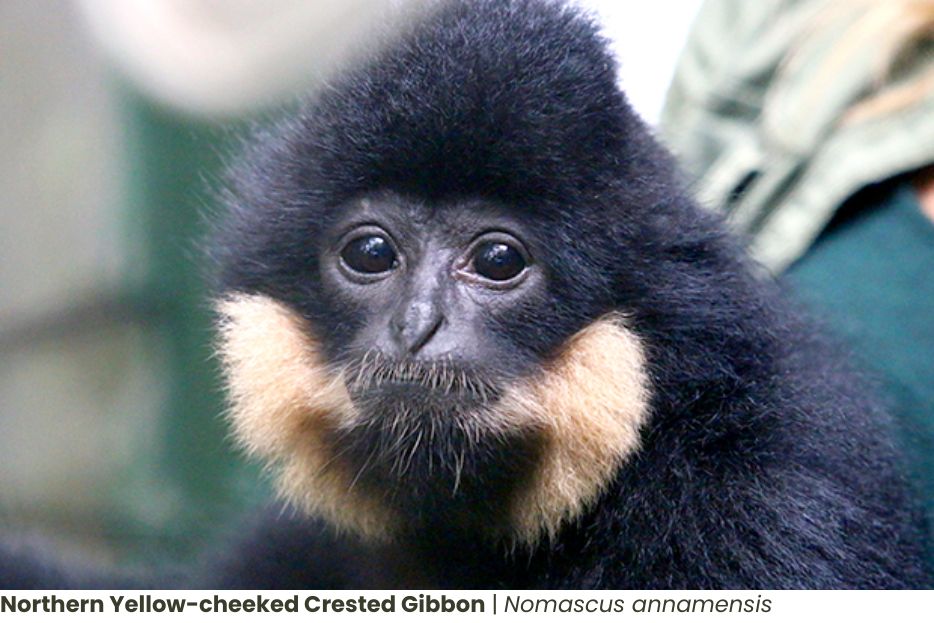
While research on the reproductive habits of the newly identified Northern Yellow-Cheeked Crested Gibbon species is pending, insights from studies on their southern yellow-cheeked crested relatives provide some understanding. Following mating, a female Northern Yellow-Cheeked Gibbon undergoes a seven-month pregnancy. The newborn, blending seamlessly with its mother’s light-colored fur, relies entirely on her initially. Nursing continues for several months before the young gibbon gradually explores its canopy surroundings, observing and mimicking its parents’ behaviors, including learning their songs. Acquiring the knowledge and skills necessary for survival, the young gibbon reaches sexual maturity between seven and eight years, eventually leaving the family to start its own.
Females, leading similar lives, may leave the group earlier and typically give birth for the first time between seven and eight years of age. Given the demanding nature of raising offspring, both gibbon parents contribute, and mothers usually wait until the current offspring can manage somewhat independently before having another. A typical gibbon family comprises two parents, a juvenile, and an infant at any given time.
Conservation Status:

Categorized as Endangered due to a suspected population reduction exceeding 50% over the past 45 years, the Northern Yellow-Cheeked Crested Gibbon (Nomascus annamensis) faces a multifaceted threat landscape. The decline is primarily attributed to logging, agricultural encroachment, and hunting, with ongoing challenges related to habitat loss, fragmentation, and the impacts of wildlife trade.
In Vietnam, key populations are documented in Dak Rong and Phong Dien Nature Reserve, with over 220 groups recorded between 2000 and 2015. Notable counts include 56 groups in Dak Rong, 26 in Phong Dien, and various others in protected areas. Cambodia’s Virachey National Park harbors a substantial population, exceeding 2000 groups, making it a crucial stronghold. The lack of recent population data in Laos presents uncertainties, but potential significant populations exist in In Xe Pian NPA.
The species faces rampant habitat loss, degradation, and hunting for food and the pet trade. In Cambodia, the clearing of large areas for rubber plantations and illegal logging pose significant threats. Lack of enforcement and hunting with firearms remain pervasive challenges. While international trade data is limited, gibbons are generally traded for meat and, to a lesser extent, as pets, with cross-border trade exacerbating the issue.
Conservation efforts are vital, emphasizing habitat protection, population monitoring, and controlling hunting. Projects by WWF, Conservation International, and Fauna & Flora International aim to address these challenges in key landscapes. Rigorous environmental impact studies for development projects are recommended, and a concerted international effort is crucial for the survival of the Northern Yellow-Cheeked Crested Gibbon.
Why don’t you visit Vietnam on a primate discovery tour? Click here.
Wildlife Tours into the Vietnam Primate Kingdom
The Northern Yellow-Cheeked Crested Gibbon (Nomascus annamensis) is currently listed as Endangered due to a suspected population decline exceeding 50% over the past 45 years, primarily attributed to logging, agricultural encroachment, and hunting. Ongoing threats include habitat loss, fragmentation, and wildlife trade. Recent genetic and vocal studies have clarified its specific identity, revealing six distinct crested gibbon species.
Recognized for their challenging visual identification in the wild, these diurnal and arboreal primates play essential roles as seed dispersers. While the reproductive habits of the newly identified species require further research, general gibbon behavior involves monogamous relationships forming the nucleus of the nuclear family, with both parents actively raising offspring. Conservation efforts are underway, but the pervasive threats demand a concerted international endeavor to ensure the survival of this endangered species and its ecological contributions.
Across Vietnam, conservation efforts are expanding—from reforestation projects to wildlife rescue and habitat protection. At WANEE, we believe that the more we appreciate nature, the more we’ll want to protect it. That’s why our tours are designed to inspire a deeper love for wildlife and a stronger commitment to conservation.
While trying harder every day to protect the balance of nature, our wildlife tours give tourists the chance to explore Vietnam’s natural beauty, understand how different habitats connect, and take action to protect them.
Scheduled Wildlife Tours
Tailored Wildlife Tours
Click here to see more tailored tour options
Visit our sites:
– Facebook: WANEE Vietnam (Wild and Nature Exploring)
– Instagram: WANEE Vietnam and WANEE Kids hub
Hot-spot for Birding in Vietnam
all birding in hot-spot informative info [updated Jan 2023]
Nr. Nature reserve; Np. National Park; mt. Mountain
How to Identify the Greater Sand Plover, Tibetan Sand Plover and Siberian Sand Plover
ContentsTaxonomy and Classification of Northern Yellow-cheeked Crested Gibbon:Habitat and Distribution:Behavior and Social Structure:Reproductive Biology:Conservation Status:Wildlife [...]
Highlights of Cat Tien National Park Reptiles and Amphibian Endemics
Spanning over 71,350 hectares of tropical forests, grasslands, and wetlands, Cat Tien National Park is [...]
Highlights of Cat Tien National Park Mammals in a World Biosphere Reserve
In addition to reptiles and birds, Cat Tien National Park is also rich in mammals, [...]
Kontum Plateau Endemic and Highlight bird
Kontum Plateau Endemic And Highlight Bird species like Chestnut-eared Laughingthrush and top birding routes while [...]
Dalat Plateau Endemic and highlight bird
The Dalat Plateau is a birdwatcher’s paradise, renowned for its exceptional biodiversity and unique highland [...]
Cat Tien National Park Endemic and Highlighted Birds
Covering 71,920 hectares in southern Vietnam, Cat Tien National Park is home to a number [...]